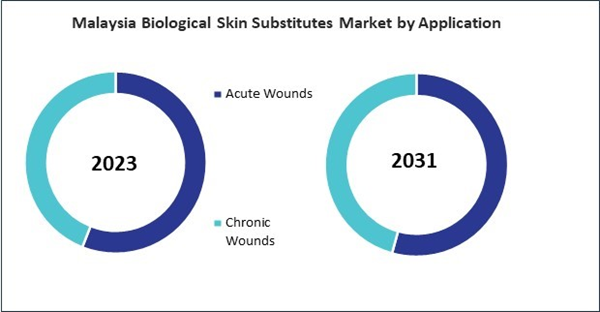The Asia Pacific Biological Skin Substitutes Market is expected to witness market growth of 9.2% CAGR during the forecast period (2024-2031).
The China market dominated the Asia Pacific Biological Skin Substitutes Market by country in 2023, and is expected to continue to be a dominant market till 2031; thereby, achieving a market value of $38.89 millions by 2031. The Japan market is registering a CAGR of 8.6% during 2024-2031. Additionally, the India market is expected to showcase a CAGR of 10% during 2024-2031.
The primary role of biological skin substitutes is to serve as a temporary or permanent cover for skin wounds, creating an environment that fosters cellular regeneration and tissue repair. Traditionally, wound care involved basic dressings or autologous skin grafts, where skin from another part of the patient's body would cover the wound. However, in cases of severe burns or extensive wounds, autologous grafting often falls short, as patients may lack sufficient skin for grafting, or the procedure may lead to further complications such as infections or graft rejection.
Moreover, biological skin substitutes offer a valuable alternative by providing a more biocompatible, stable solution that aids in faster recovery. For patients with chronic wounds - such as those caused by diabetes, venous insufficiency, or prolonged immobility - these substitutes have become an essential component of modern wound care, as they reduce healing time and minimize the risk of complications associated with slow-healing wounds.
Biological skin substitutes are experiencing substantial development in the Asia Pacific region, which is being driven by the increasing prevalence of chronic diseases, burn injuries, and a large aging population. Japan, facing one of the most rapidly aging populations, with nearly 29% of its residents aged 65 or older, also has a high demand for long-term care and effective chronic disease management solutions. Advanced wound care products, such as biological skin substitutes, are in high demand in Japan as a result of the strain on the healthcare infrastructure caused by an aging population.
The China market dominated the Asia Pacific Biological Skin Substitutes Market by country in 2023, and is expected to continue to be a dominant market till 2031; thereby, achieving a market value of $38.89 millions by 2031. The Japan market is registering a CAGR of 8.6% during 2024-2031. Additionally, the India market is expected to showcase a CAGR of 10% during 2024-2031.
The primary role of biological skin substitutes is to serve as a temporary or permanent cover for skin wounds, creating an environment that fosters cellular regeneration and tissue repair. Traditionally, wound care involved basic dressings or autologous skin grafts, where skin from another part of the patient's body would cover the wound. However, in cases of severe burns or extensive wounds, autologous grafting often falls short, as patients may lack sufficient skin for grafting, or the procedure may lead to further complications such as infections or graft rejection.
Moreover, biological skin substitutes offer a valuable alternative by providing a more biocompatible, stable solution that aids in faster recovery. For patients with chronic wounds - such as those caused by diabetes, venous insufficiency, or prolonged immobility - these substitutes have become an essential component of modern wound care, as they reduce healing time and minimize the risk of complications associated with slow-healing wounds.
Biological skin substitutes are experiencing substantial development in the Asia Pacific region, which is being driven by the increasing prevalence of chronic diseases, burn injuries, and a large aging population. Japan, facing one of the most rapidly aging populations, with nearly 29% of its residents aged 65 or older, also has a high demand for long-term care and effective chronic disease management solutions. Advanced wound care products, such as biological skin substitutes, are in high demand in Japan as a result of the strain on the healthcare infrastructure caused by an aging population.
List of Key Companies Profiled
- Smith & Nephew plc
- Stryker Corporation
- MIMEDX Group, Inc.
- Organogenesis Holdings, Inc.
- Integra LifeSciences Corporation
- 3M Company
- Essity AB (BSN Medical)
- Zimmer Biomet Holdings, Inc.
- Vericel Corporation
- Molnlycke Health Care AB
Market Report Segmentation
By Type
- Human Donor Tissue-derived Products
- Acellular Animal-derived Products
By End Use
- Hospitals
- Outpatient Facilities
- Research & Manufacturing
By Application
- Acute Wounds
- Chronic Wounds
By Country
- China
- Japan
- India
- South Korea
- Singapore
- Malaysia
- Rest of Asia Pacific
Table of Contents
Chapter 1. Market Scope & Methodology
Chapter 2. Market at a Glance
Chapter 3. Market Overview
Chapter 4. Competition Analysis - Global
Chapter 5. Asia Pacific Biological Skin Substitutes Market by Type
Chapter 6. Asia Pacific Biological Skin Substitutes Market by End Use
Chapter 7. Asia Pacific Biological Skin Substitutes Market by Application
Chapter 8. Asia Pacific Biological Skin Substitutes Market by Country
Chapter 9. Company Profiles
Companies Mentioned
Some of the leading companies profiled in this Asia-Pacific Biological Skin Substitutes Market report include:- Smith & Nephew plc
- Stryker Corporation
- MIMEDX Group, Inc.
- Organogenesis Holdings, Inc.
- Integra LifeSciences Corporation
- 3M Company
- Essity AB (BSN Medical)
- Zimmer Biomet Holdings, Inc.
- Vericel Corporation
- Molnlycke Health Care AB
Methodology

LOADING...









